
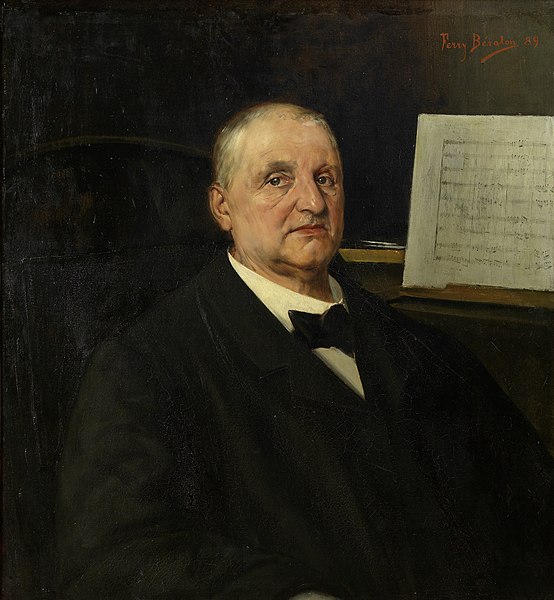
Anton Bruckner‘s Symphony No. 7 in E major, WAB 107, is one of his best-known symphonies. It was written between 1881 and 1883 and was revised in 1885. It is dedicated to Ludwig II of Bavaria. The premiere, given under Arthur Nikisch and the Gewandhaus Orchestra in the opera house at Leipzig on 30 December 1884, brought Bruckner the greatest success he had known in his life. The symphony is sometimes referred to as the “Lyric”, though the appellation is not the composer’s own, and is seldom used.
In the article “The 20 Greatest Symphonies of all time” from BBC Music Magazine, this symphony is placed at the 20th position. Bruckner also holds the 13th place with Symphony No. 8.
Description
The symphony has four movements:
- Allegro moderato (E major)
- Adagio: Sehr feierlich und sehr langsam (C♯ minor)
- Scherzo: Sehr schnell (A minor) – Trio: Etwas langsamer (F major)
- Finale: Bewegt, doch nicht schnell (E major)
First movement
The first movement starts with tremolo strings and the cellos presenting “a complete, divinely given melodic whole:”

“Bruckner declared he heard it in a dream, played on a viola, and wrote it down on awakening, but the tune incorporates a quotation from the Credo of his D minor Mass (1864) which he was currently revising The main
theme is restated before the second theme group appears, with the oboes and clarinets carrying the first theme:

The third theme group is based on octaves, as is typical in Bruckner:

The development features many of the themes in inversion. Near the end of the movement, there is a long pedal point on E, sustained by the double basses and timpani.
Second movement
This movement was composed between January and April 1883. Bruckner began writing it in anticipation of the death of Richard Wagner, who was in poor health. The movement features four Wagner tubas, which was their first appearance in a symphony:

A contrabass tuba is also present. The second part of the movement, beginning in F♯ major, has a tune that Bruckner specialist Georg Tintner described as such: “If I could describe what makes Bruckner Bruckner to me, it is that tune. It is something which transcends ordinary sorts of feelings. You can’t even say ‘Is it jolly?’ ‘Is it sad?’ ‘Is it that?’ ‘Is it that?’. You can’t say that with a late Beethoven tune either. It is above these things:”

Legend has it that Bruckner wrote the cymbal clash at the climax of this movement upon hearing the news that Wagner had died. By way of contrast, Williman Mann states that “at the climax of the slow movement Nikisch persuaded Bruckner to add a cymbal clash supported by a triangle; later this addition to the manuscript was marked ‘invalid’ – but not in the composer’s hand, so who was the purist?”
Third movement
The scherzo is in A minor and opens with a rhythmic string figure and a melody with a leap of an octave played by a solo trumpet:

The Trio is in F major and is in a slower tempo:

Fourth movement
Unlike the Fifth and Eighth symphonies, where the Finale sums up the entire symphony, this Finale is not as expansive as the other movements. Georg Tintner compared this Finale to the finale of a Haydn symphony. Like the first movement, the fourth movement opens with tremolo strings:

The second theme group is in the distant key of A♭ major:

The third theme group is a characteristic “octave theme” given by the whole orchestra in A minor:

In the recapitulation, the subject groups are reversed in order – a form called “tragic sonata form”[7] or “arch form”
Versions
1883 version
This was the version performed at the work’s premiere. It survives only in one autograph copy which includes later changes by Bruckner and others, so the exact contents of this version are lost and it is unpublished.
1885 version
Gutmann edition (published 1885)
Some changes were made after the 1884 premiere but before the first publication by Gutmann in 1885. It is widely accepted that Nikisch, Franz Schalk and Ferdinand Löwe had significant influence over this edition, but there is some debate over the extent to which these changes were authorized by Bruckner. These changes mostly affect tempo and orchestration.
Haas edition (published 1944)
Robert Haas attempted to remove the influence of Nikisch, Schalk and Löwe in order to retrieve Bruckner’s original conception of the symphony. Haas used some material from the 1883 autograph but because this autograph also includes later changes much of his work was the product of conjecture. The most prominent feature of Haas’s edition is the absence of cymbals, triangle and timpani in the slow movement: Haas asserted that Bruckner decided to omit the percussion, a claim scholar Benjamin Korstvedt deems “implausible”.
Nowak edition (published 1954)
Leopold Nowak kept most of the changes in the 1885 Gutmann edition, including the percussion. He reprinted the tempo modifications from Gutmann but placed them in brackets. Some performances of this edition omit the cymbal crash at the climax of the slow movement, but it is included in the printed score.
1921 chamber arrangement
An arrangement of this symphony for chamber ensemble (consisting of 2 violins, viola, cello, bass, clarinet, horn, piano 4-hands, and harmonium) was prepared in 1921 by students and associates of Arnold Schoenberg, for the Viennese “Society for Private Musical Performances“: Hanns Eisler (1st and 3rd movements), Erwin Stein (2nd mvt.), and Karl Rankl (4th mvt.). The Society folded before the arrangement could be performed, and it was not premiered until more than 60 years later.
Instrumentation
The symphony requires the following orchestra:
- woodwinds: 2 flutes, 2 oboes, 2 clarinets in A, 2 bassoons
- brass: 4 horns in F, 3 trumpets in F, 3 trombones, 4 Wagner tubas (2 tenors in B♭, 2 basses in F)1, contrabass tuba
- percussion2: timpani, cymbals, triangle
- strings: violins 1, 2, violas, violoncellos, double basses
1Used in the 2nd and 4th movements only.
2Except for the third movement where the timpani figure prominently, use of percussion in the symphony is extremely limited. A timpani roll enters at the coda of the first movement. In some performance editions, the timpani re-enters along with cymbals and triangle together in the climax of the second movement (the only movement employing cymbals and triangle). Many conductors perform the second movement without percussion (as in the Haas edition), however; the decision is generally settled by the performers’ preferences. In the last movement, the timpani rolls in brief climaxes before crescendoing with orchestral tutti in the final bars.
Discography
The first commercial recording was made by Oskar Fried with the Berlin State Opera Orchestra in 1924 for Polydor. Along with Symphony No. 4, the Seventh is the most popular Bruckner symphony both in the concert hall and on record.
Herbert von Karajan‘s last recording with the Vienna Philharmonic, 23 April 1989, three months before his death, on the Deutsche Grammophon label, of the Haas edition of the 1885 score, has been singled out by Norman Lebrecht as #80 in his list of the 100 best recordings, and described as “more human and vulnerable” than his earlier Berlin recording. In reviewing the 1999 recording by Kurt Sanderling, the critic David Hurwitz listed as reference (benchmark) recordings of Bruckner’s Seventh those by Eugen Jochum in 1976, Bernard Haitink in 1978, Karajan in 1989, and Günter Wand in 1999. Stephen Johnson prefers Karl Böhm‘s recording with the Vienna Philharmonic, saying that Böhm balances “clear-sighted formal understanding with a more fluid, supple approach to phrasing.” The vast majority of modern recordings use vibrato for the strings, with Roger Norrington‘s recording with the Radio-Sinfonieorchester Stuttgart des SWR being a notable exception.
On BBC Radio 3 in December 2014, John Deathridge selected Bernard Haitink’s Concertgebouw recording from 1966 as the ‘First Choice’ in the ‘Building a Library’ series. (Wilhelm Furtwangler’s 1949 recording with the Berlin Philharmonic was chosen as the top ‘Historic’ recommendation.)
The chamber arrangement has been recorded, by among others, the Thomas Christian Ensemble, proving to one reviewer “beyond doubt that it simply takes more than 10 musicians, no matter how good they are, to play a Bruckner symphony.” https://en.wikipedia.org/wiki/Symphony_No._7_(Bruckner)
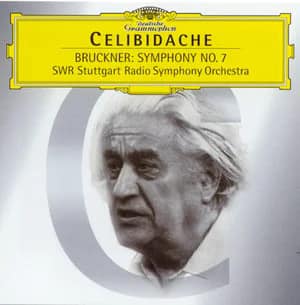
Met Stuttgart Radio Symphony Orchestra vind ik niet op internet
Sergiu Celibidache felt a particular spiritual affinity with the symphonies of Anton Bruckner. They constituted the core of his repertoire, and he had very strong opinions about their performance, referring to other “so-called Bruckner conductors” as “camel drivers” who “haven’t understood the first thing about Bruckner.” Whatever one thinks of Celibidache’s rhetoric, these live 1970’s performances, part of Deutsche Grammophon’s Celibidache Edition, allow us to hear how this famously elusive conductor (he hated recordings) actually played Bruckner. Celibidache protested that recordings were “not music”, and philosophically, at least, he had a point. There are innumerable phenomena taking place during a performance that are not captured by sound recording devices. Perhaps it’s these missing intangible aspects that bar these performances from the realm of the extraordinary. Because, despite all the legend and hype, what we have here is some pretty much standard Bruckner, recorded in not very good sound. By comparison, the later EMI recordings with the Munich Philharmonic (in first-class sound) feature readings that, with their amazingly slow tempos and shockingly sustained intensity of orchestral playing over the long time-spans, better represent Celibidache’s musico-mystic image. Symphony No. 7 runs a little over an hour on the DG set, and except for some added timpani rolls in the adagio’s climax, comes off as pretty straightforward. The Stuttgart Eighth sounds rushed compared to the Munich performance, which clocked in at over 100 minutes. Only the finale’s unusually broad pacing hints at the incredible expansion that was to come. Celibidache’s Stuttgart Ninth, the freshest, most direct performance of the three, moves along in a very brisk manner which comes as a shock after his big, heavy and very long EMI account. Okay, so what’s so special about this DG set? Perhaps the answer lies in Celibidache’s concept of orchestral sound itself. Unlike his last years, during which he strove for ultimate clarity of inner detail and musical line, Celibidache’s earlier Stuttgart style aims at just the opposite– heavily blended sonorities, smoothed accents and rounded attacks–mannerisms that may have sounded transcendental in performance, but which in these dynamically limited and recessed recordings make the music sound soft-edged and underplayed. At least the EMI recordings present a Bruckner experience you won’t hear anywhere else (whether or not you’ll want to hear it very often remains an open question). Barring those, and unless you really want the coupled Schubert Symphony No. 5 (a fine reading) or the bonus disc of Celibidache painstakingly rehearsing the same few minutes of the Seventh and Eighth symphonies over and over (in German), go for Eugen Jochum’s contemporaneous and far more idiomatic performances with the Dresden Staatskapelle on EMI. — From ClassicsToday.com


Symphony No 7 in E Major by Anton Bruckner 1. Allegro moderato 2. Adagio, sehr feierlich und langsam 3. Scherzo: Sehr schnell 4. Finale: Bewegt, doch nicht zu schnell Czech Philharmonic Orchestra Lovro von Matacic, Conductor 1967
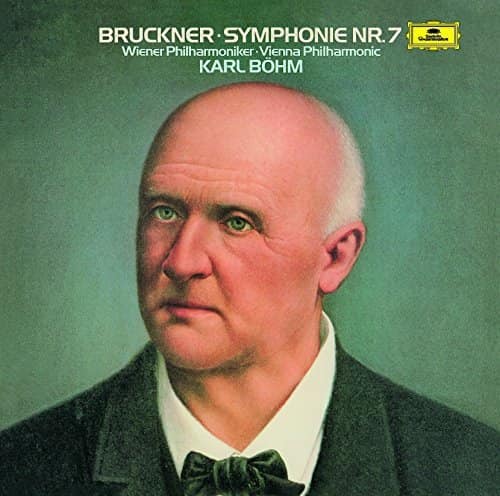
Symphony No 7 by Anton Bruckner 1. Allegro moderato 2. Adagio 3. Scherzo 4. Finale Wiener Philharmoniker Karl Böhm, Conductor 1943
Symphony n°7 I. Allegro moderato 0:00 II. Adagio. Sehr feierlich und sehr langsam 18:47 III. Scherzo. Sehr schnell 41:38 IV. Finale. Bewegt doch nicht schnell 51:14 Wiener Philharmoniker Karl Böhm Live recording, Vienna, 7.III.1953
Symphony No. 7 E Major by Anton Bruckner 1. Allegro moderato 2. Adagio. Sehr feierlich und sehr langsam 3. Scherzo. Sehr schnell 4. Finale. Bewegt, doch nicht schnell Wiener Philharmoniker Karl Böhm, Conductor IX.1976
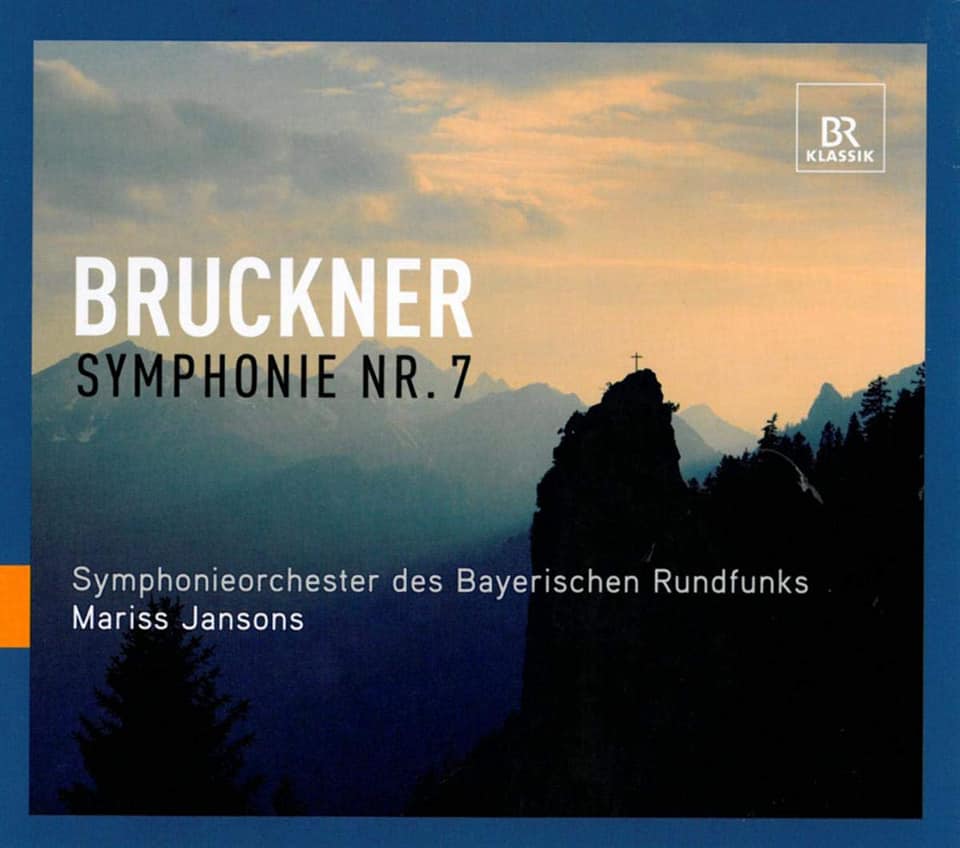
Symphony No 7 in E Major Anton Bruckner 1. Allegro moderato 2. Adagio. Sehr feierlich und sehr langsam 3. Scherzo. Sehr schnell 4. Finale: bewegt, doch nicht zu schnell Symphonieorchester des Bayrischen Rundfunks Mariss Jansons, Conductor
Leningrad Philharmonic Orchestra, Mariss Jansons, conductor Grand Hall of Leningrad Philharmonic, 25.12.1994 (Radio Petersburg) I. Allegro moderato II. Adagio. Sehr feierlich und sehr langsam III. Scherzo. Sehr schnell IV. Finale. Bewegt, doch nicht schnell
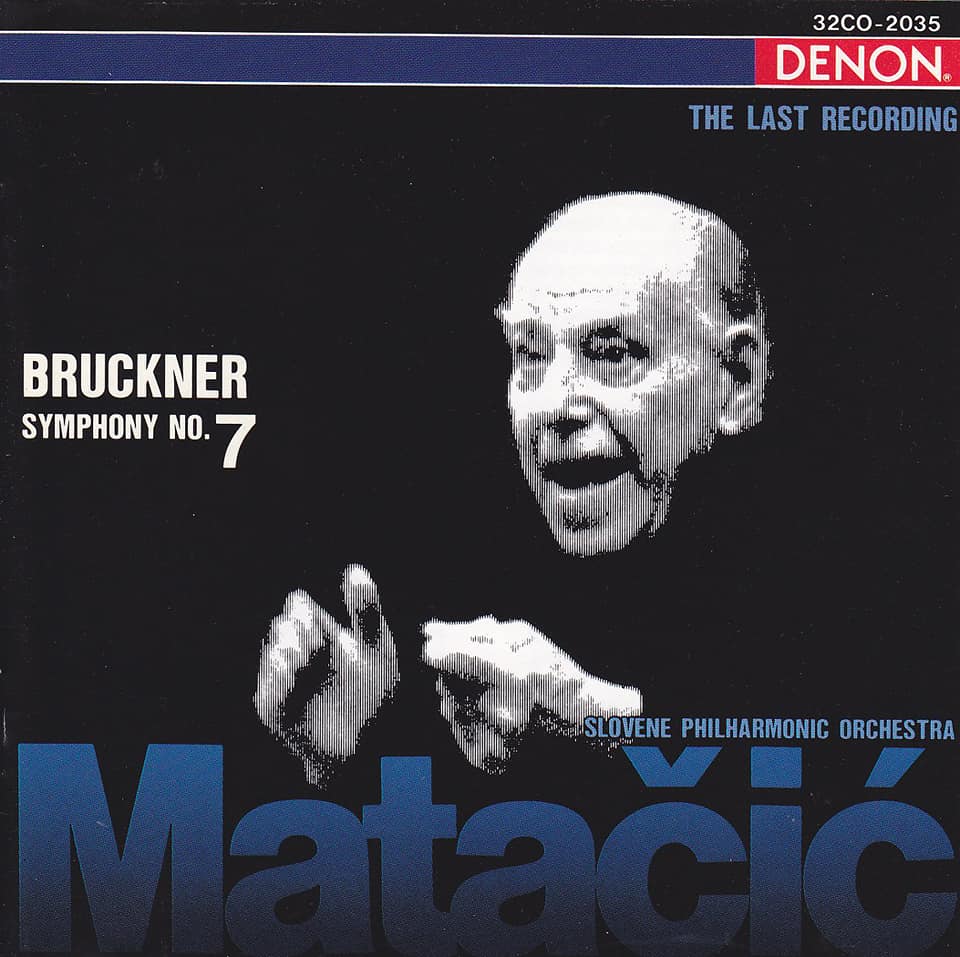

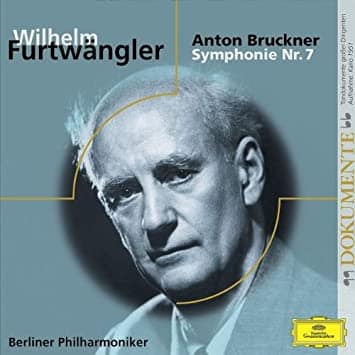
Symphony No 7 in E Major by Anton Bruckner 1885 Version with some modifications by Bruckner (ed.Albert Gutmann) 1. Allegro moderato 2. Adagio: Sehr feierlich und sehr langsam 3. Scherzo: Sehr schnell 4. Finale: Bewegt, doch nicht zu schnell Philharmonic Orchestra Berlin Wilhelm Furtwängler, Conductor
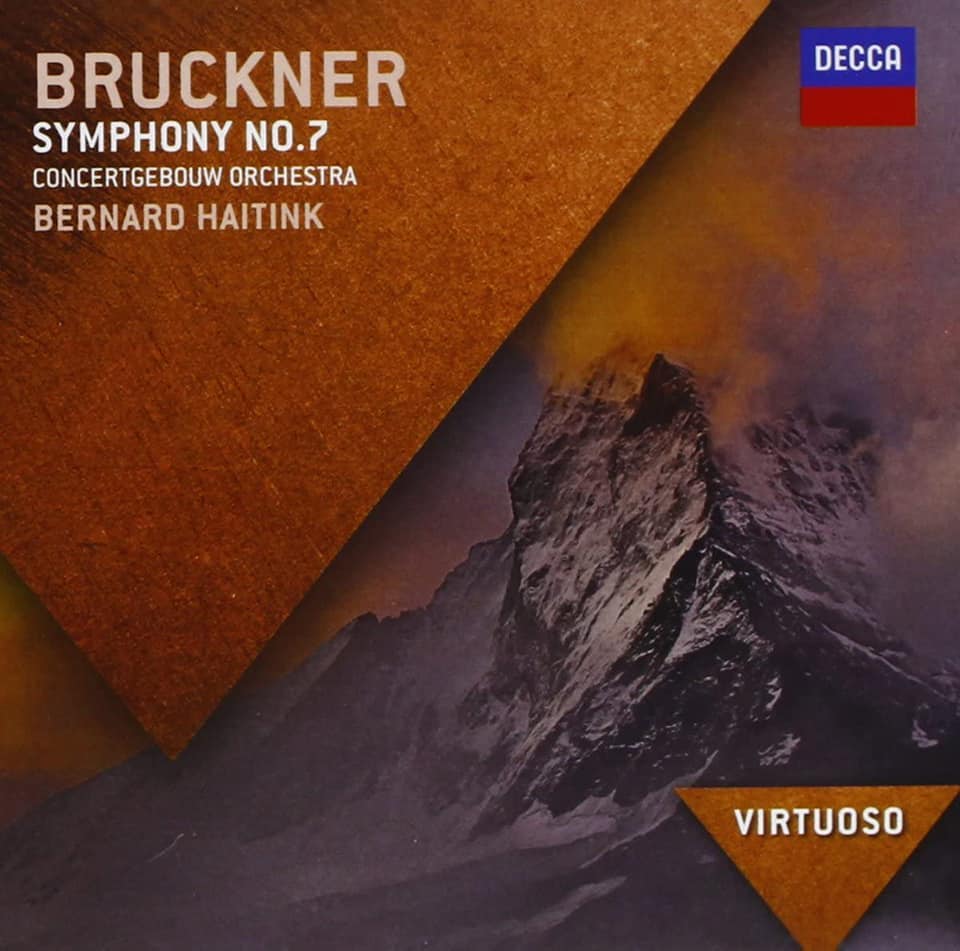
Radio Filharmonisch Orkest Bernard Haitink, dirigent Camilla Tilling, sopraan Strauss – uit Vier Lieder op.36: Das Rosenband Strauss – uit Sechs Lieder op.68: Ich wollt ein Sträusslein binden Strauss – uit Sechs Lieder op.68: Säusle, liebe Myrte Strauss – uit: Sechs Lieder op.56: Die heiligen drei Könige aus Morgenland Strauss – uit Vier Lieder op.27: Morgen Bruckner – Zevende symfonie

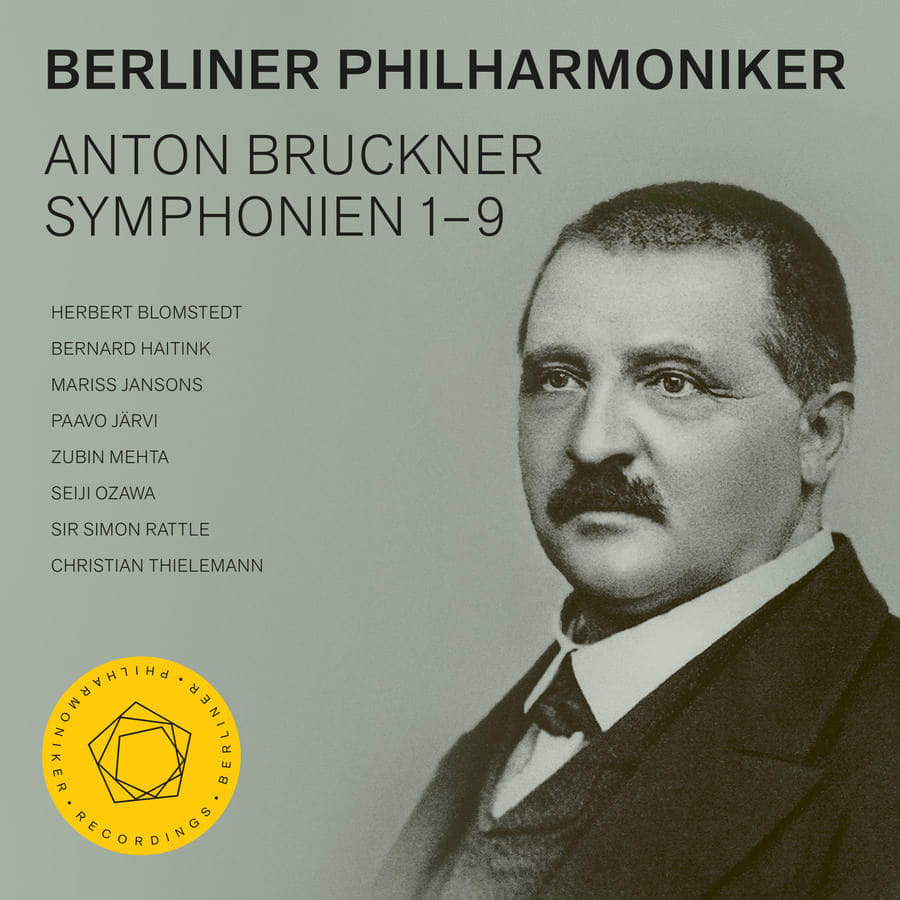
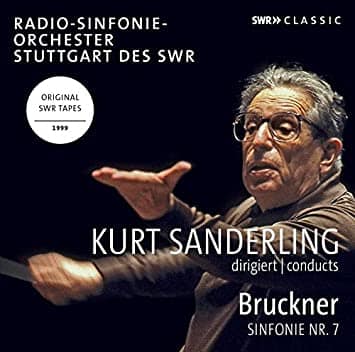
Symphony No. 7 in E Major, WAB 107: I. Allegro moderato · Radio-Sinfonieorchester Stuttgart des SWR Bruckner: Symphony No. 7, WAB 107 ℗ 2018 SWR Classic Released on: 2018-02-09 Conductor: Kurt Sanderling Orchestra: Radio-Sinfonieorchester Stuttgart des SWR Composer: Anton Bruckner
Symphony No 7 by Anton Bruckner 1. Allegro moderato 2. Adagio 3. Scherzo 4. Finale Danish Radio Symphony Orchestra Kurt Sanderling, Conductor Danish Radio Concert Hall, 13.& 14.I 1977

Anton Bruckner Symphony No. 7 in E major I. Allegro moderato II. Adagio. Sehr feierlich und sehr langsam III. Scherzo. Sehr schnell IV. Finale. Bewegt, doch nicht schnell Berliner Philharmoniker Cond.Günter Wand
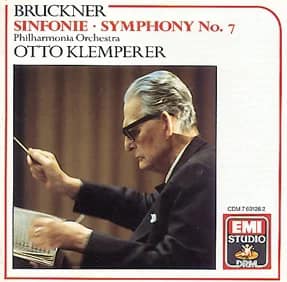
Symphony n°7 (1887 ed. Nowak 1954) I. Allegro moderato 0:00 II. Adagio. Sehr feierlich und sehr langsam 19:54 III. Scherzo. Sehr schnell – Trio. Etwas langsamer 41:45 IV. Finale. Bewegt, doch nicht zu schnell 51:27 Philharmonia Orchestra Otto Klemperer Studio recording, London, 1-5.XI.1960
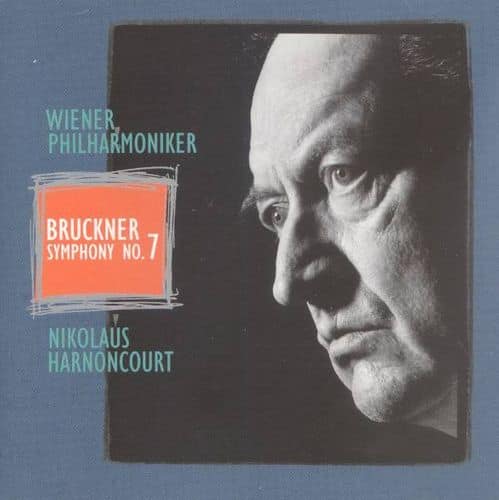
ニコラウス・アーノンクール指揮 ウィーン・フィルハーモニー管弦楽団 Nikolaus Harnoncourt / Wiener Philharmoniker June.1999 Bruckner : Symphony No.7 in E major 1. Allegro moderato 19:10 (00:03) 2. Adagio (Sehr feierlich und sehr langsam) 20:48 (19:12) 3. Scherzo (Sehr schnell) – Trio (Etwas langsamer) 8:53 (40:01) 4. Finale (Bewegt, doch nicht schnell) 11:09 (48:56)


Anton Bruckner – Symphony No. 7 in E major, WAB 107 0:00 Allegro moderato 21:05 Adagio: Sehr feierlich und sehr langsam 46:22 Scherzo: Sehr schnell – Trio: Etwas langsamer 57:06 Finale: Bewegt, doch nicht schnell Munich Philharmonic Orchestra conducted by Eugen Jochum Recorded live: 8 November 1979, Herkulessaal der Residenz München Konzertmitschnitt
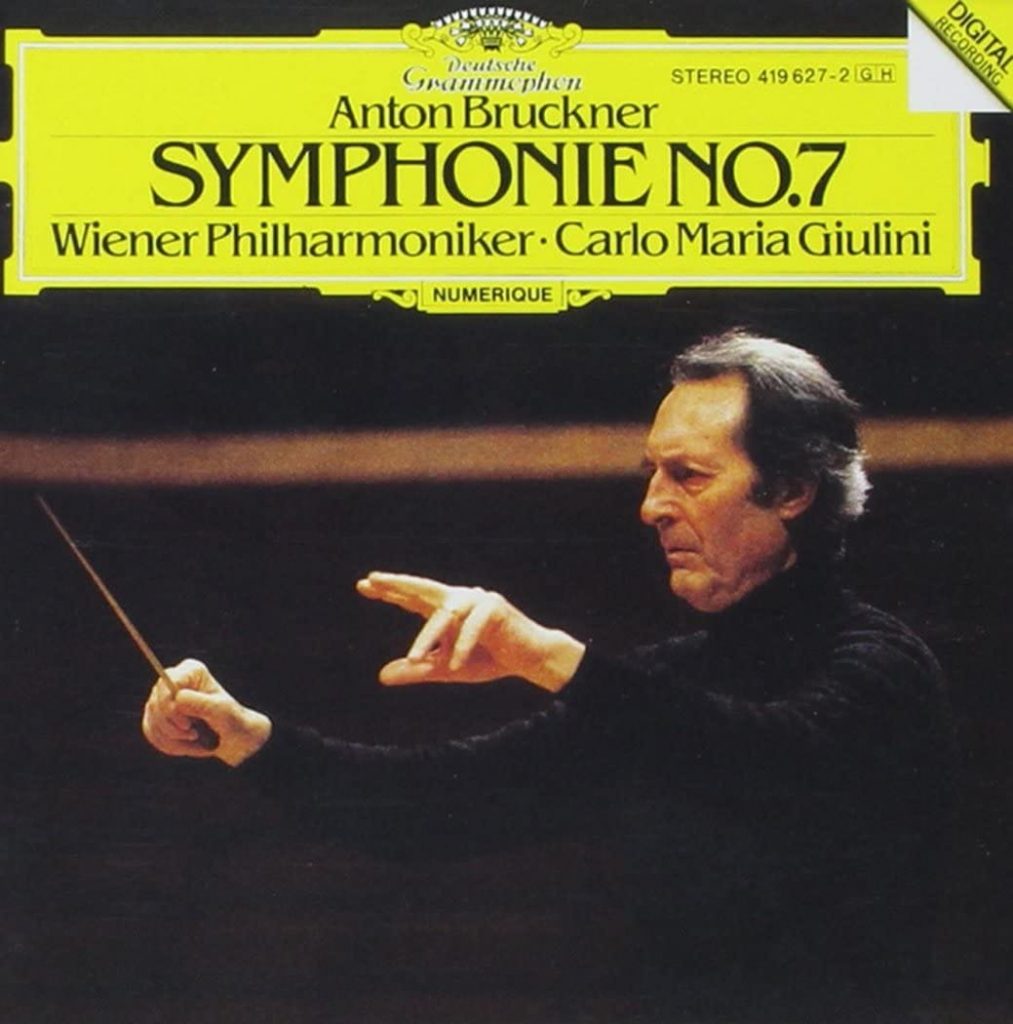
Symphony no 7 by Anton Bruckner 1.Allegro moderato 2.Adagio. (Sehr feierlich & sehr langsam) 3.Scherzo (Sehr schnell) 4.Finale (Bewegt, doch nicht zun schnell) Wiener Philharmoniker Carlo Maria Giulini, Conductor
Anton Bruckner (1824-1896) Symphony No.7 in E, WAB 107, ‘Lyric’ (00:00:00) 1. Allegro Moderato (00:20:26) 2. Adagio, Sehr Feierlich Und Sehr Langsam (00:44:41) 3. Scherzo- Sehr Schnell (00:55:18) 4. Finale- Bewegt, Doch Nicht Schnell rec. June, 1989 Symphony No.8 in C minor, WAB 108 (01:07:51) 1. Allegro Moderato (01:24:58) 2. Scherzo (01:41:23) 3. Adagio, Feierlich Langsam, Doch Nicht Schleppend (02:10:47) 4. Finale- Feierlich, Nicht Schnell rec. May, 1984 Symphony No.9 in D minor, WAB 109 (02:35:29) 1. Feierlich, Misterioso (03:03:40) 2. Scherzo- Bewegt, Lebhaft (03:14:31) 3. Adagio, Langsam, Feierlich rec. June, 1988 Vienna Philharmonic Orchestra Carlo Maria Giulini

Sex, death and dissonance: the strange, obsessive world of Anton Bruckner
There’s no doubt Anton Bruckner was an oddball, a man with an unhealthy interest in dead bodies and teenage girls. But the composer’s obsessions and terrors also gave us some astonishing music

‘A death-obsessed maniac’ … a portrait of Anton Bruckner from 1893. Photograph: Imagno/Getty ImagesTom ServiceTue 1 Apr 2014 18.00 BST
A credulous yokel who propositioned girls half his age. A death-obsessed ghoul who kept a photo of his mother’s corpse. A cranky, backwards-looking obsessive. The composer of some of the 19th century’s greatest, grandest and most ambitious symphonies. Anton Bruckner was all of these things. One thing he wasn’t, however, was a writer of beautiful music offering serene escapism.
Mariss Jansons and Amsterdam’s Concertgebouw, who visit London’s Barbican this week to perform three Bruckner symphonies, will unleash sounds of orchestral ugliness and visions of existential disturbance that will – that should – have you quaking in your seats.
These works – Bruckner’s 4th, 7th and his unfinished 9th – opened up a new musical and spiritual terrain. The titanic shocks that these paradoxical pieces delivered were achieved by a man who worshipped the gods of musical conservatism at a time when the rules of composition were being dismantled by the likes of Gustav Mahler and Richard Strauss. Bruckner, by contrast, spent his life exploring musical principles that had been laid down centuries earlier – the laws of counterpoint, the way one musical voice interacts with another – which marked him out as a cranky weirdo in the context of the progressive artistic and intellectual scene of late 19th-century Vienna.
Vienna wasn’t Bruckner’s hometown. Born in the village of Ansfelden, he trained in St Florian, a monastery town that he didn’t properly leave until his middle age, having spent his youth in a self-annihilating study of musical arcana and hours of lonely training in order to become one of the world’s greatest organists. It was only in his 40s in Vienna that Bruckner felt confident enough to embark on the symphonic project that would sustain the rest of his musical life. But in doing so, he had to face the wrath of his critics, who called him everything from “a drunkard” to the composer of “symphonic boa-constrictors” (that one was Brahms). He also had to put up with caricatures of him as a devoutly, credulously Catholic country bumpkin who propositioned teenage girls in his old age, and who once tipped a conductor with cash for getting through a rehearsal of one of his symphonies.
Actually, both of those anecdotes are all too true. And as John Butt, professor of music at Glasgow University and a Bruckner devotee, told me, Bruckner really was – well, a bit of an oddball. In his diaries, he kept lists of the girls he fancied (usually in their late teens), he had a mania for counting the bricks and windows of buildings, and for counting the numbers of bars in his gargantuan orchestral scores, making sure their proportions were statistically correct. And there were even stranger sides to this kind of behaviour: when his mother died, Bruckner commissioned a photograph of her on her death bed and kept it in his teaching room. He had no image of his mother when she was alive, just this grotesque-seeming token of her death staring out at him as an unsettling memento mori. Butt also recalls accounts of Bruckner having “fingered and kissed the skulls of Beethoven and Schubert” when their corpses were exhumed and moved to a different cemetery; that Bruckner had requested permission to see the skull of a dead cousin (he was refused), and also that of the Emperor Maximilian, whose body was returned to Vienna after his execution in Mexico in 1867.

Bruckner: death-obsessed maniac. Well, partly. But as Butt says, “in the way that some obsessives don’t get anywhere in life, others get there in a very quirky way”. Bruckner’s peculiar brand of musical obsessiveness produced visions of grandeur that are at once ancient and modern. You hear that in the opening of the 4th symphony’s final, fourth movement – a chilling, dehumanised orchestral landscape in sound; in the emotional desolation of the 7th symphony’s slow movement, a tribute to the recently dead Wagner; and throughout the three completed movements of the 9th.
For me, this is Bruckner’s boldest compositional achievement. The symphony is the only one of his that’s explicitly dedicated to God. In a sense all of Bruckner’s music is a tribute to his devout faith, but the 9th dares something darker, more doubting, more apocalyptic, and more ear-shatteringly aggressive and even deliberately ugly than he had attempted before. The massively loud and dissonant orchestral pile-up of a chord near the end of the third movement is a vision of a despairing abyss that the quiet music that comes after it can’t possibly console. It’s as if Bruckner shrinks back from the vision his exquisitely arcane brain had led him to. That chord is the product of a passage of music that behaves entirely according to the laws of musical structure that the composer revered. Yet all that careful construction reveals something so strange, so shocking, and so disturbing – all the more so because the music has the irresistible power of a force of nature rather than a subjective, personal scream. It’s a moment that’s a transfiguration of all that obsessiveness. This isn’t Bruckner’s shout into the void, but the cosmos itself in pain. At least, that’s what it sounds like to me; in the Concertgebouw’s performance, it will confront the Barbican audience with violent sonic terrors. I hope that audience is ready. https://www.theguardian.com/music/2014/apr/01/sex-death-dissonance-anton-bruckner-concertgebouw-orchestra
———————————-
De cultische verbreiding van het getal 7 is enorm groot. Zowel in de oudste geschriften van de Hindoes, de Veda’s, als in die van Chaldeeuws-Babylonische oorsprong, van de Perzen, de Egyptenaren, de joden en de Grieken, in overleveringen van indianen, in mythen en sprookjes enz. enz., overal treffen we in deze ‘fundamenten’ het getal 7. Hoewel ongetwijfeld hier en daar culturele relaties bestonden, betreffen die toch maar een deel, in elk geval onvoldoende voor een bevredigende verklaring van het op zo’n bijzondere wijze verschijnen – door alle tijden heen en over de hele wereld – van dit getal. Als echter in deze tijd af en toe mensen te kennen geven dat 7 ‘een heilig getal’ is, dan heeft dat in de meeste gevallen niet meer om het lijf dan de huidige cultuur in deze te bieden heeft. Op een of andere wijze, direct of indirect, heeft het kwalitatieve aspect van 7 betrekking op een geheel, een volkomenheid, een bepaalde afronding in de tijd, die deel uitmaakt van een cyclisch geheel, dan wel een verbinding geeft van deze wereld met een goddelijke. Zo zijn in veel overleveringen waar dit getal deel van uitmaakt, aanwijzingen te vinden op wat in esoterische zin betrekking heeft op de Schepping van mens en wereld en op het wordingsproces daarvan in de tijd. De beeldingen waarin de bovenzinnelijke schouwing van deze Kosmogenesis en Antropogenesis zich uitdrukt, vormen een onlosmakelijk geheel; het getal 7 neemt daarin steeds een bijzondere positie in. 1 Om uit de vele ‘omgevingen’ waarin het kwalitatieve aspect van 7 tot uitdrukking komt, een representatieve selectie te maken, is een wat arbitraire zaak. Bij het laatste van de gekozen voorbeelden zullen we ons nog even verdiepen in de enigszins moeilijk op te sporen, maar bijzondere wijze waarop dit aspect van 7 ook binnen de regelmatige lichamen tot uitdrukking komt. Wellicht is bij dit alles nog een waarschuwing op zijn plaats. In de te Neurenberg gehouden voordrachtencyclus over ‘Die Apokalypse des Johannes’ wijst Rudolf Steiner op het karakter van de Apocalyps als beschrijving van het verloop der inwijdingen, of misschien beter gezegd van de inwijdingsbelevenissen ‘des christlich Einzuweihenden’. Evenals bij de ontwikkeling van het bewustzijn van de mens in de loop der evolutietijdperken, spelen daarbij bepaalde getalsbegrippen een rol, in het bijzonder het getal 7. Hij zegt dan: ‘Een dergelijke indeling geeft niet meer dan een gedachtenschema dat behulpzaam is om tot enig begrip te komen. Het is niet meer dan een voorstelling die de mens zich in de tegenwoordige tijd kan maken van een occulte werkelijkheid. Vergelijk het met de steigers tijdens de bouw van een huis: een tijdlang nodig maar zie ze niet aan voor het huis zelf.’ 2 Ongetwijfeld zijn ook elders in deze studie plaatsen aan te wijzen waar die woorden geciteerd zouden kunnen worden. Het betreft in zekere zin de oude waarschuwing om het kleed van de waarheid niet voor de waarheid zelf aan te zien. Vandaar ook, als het om het kwalitatief aspect van getallen gaat, dat onze voorkeur veelal uitgaat naar de uitdrukking ‘verwijst naar’ in plaats van ‘betekent dat ‘, resp. ‘is dat’.http://www.stichtingopenveldwerk.nl/pdf/A%20.Expressiemogelijkheid%20van%20getallen/A166-186.%20Hfst%20IX%20%20%20%20%20%20%20%20(Het%20getal%207).pdf
De idee van zeven ontwikkelingsfases neemt een belangrijke plaats in de antroposofie waar Rudolf Steiner de grondlegger van is. Zijn gedachtegoed bevat een absoluut, allesomvattend en nauwelijks te bevatten model over de mens en zijn plaats in de kosmos. Tijdens zeven fases (Oude Saturnus, Oude Zon, Oude Maan, Aarde (de huidige tijd), Nieuwe Jupiter, Nieuwe Venus, Nieuwe Vulcanus) incarneren zeven soorten wezens (mineralen, planten, dieren, mensen, engelen, aartsengelen, archai) in een andere vorm waardoor ze elkaars eigenschappen overnemen. Wij mensen zitten precies in het midden als het vierde wezen en we leven nu in het vierde tijdperk. Hierom hebben we vier soorten lichamen: fysiek, etherisch, astraal en het ik. In het vierde centrale tijdperk is onze ziel volledig ingedaald in de stof en nu moeten met Christus als voorbeeld weer de weg omhoog zoeken, een proces dat Steiner involutie noemde. Veel antroposofische ideeën over het ontstaan van het zonnestelsel, de evolutie en ontwikkeling van de mens stroken niet met de gangbare wetenschappelijke verklaringen en moeten mijns inziens meer als een zinnebeeld worden gezien van processen in het universum. https://www.tijdgeest.eu/artikelen/numerologie-typologieen
Pythagorische getallensymboliek
Moderne numerologie baseert zich eerder op gematria, het kabbalistische systeem, dan op de getallenleer van Pythagoras. Toch wordt in leerboeken over numerologie naar zijn opvattingen verwezen als deel uitmakend van de theorieën achter de verborgen betekenissen van getallen.
- De monade – vereerd door de pythagoreeërs als een tweeslachtig getal dat noch geheel mannelijk, noch geheel vrouwelijk was. Symbool voor de wijsheid omdat het verstand stabiel is, en van God omdat vanuit de monade alle dingen ontstaan.
- De duade (of ‘dyade’) – verbonden met stoutmoedigheid omdat het het eerste getal is dat zich van de ‘Goddelijke Eén’ afscheidde. Symbool van onwetendheid en teken van polariteit. Staat ook bekend als het ‘genius’, het kwaad, de duisternis, de moeder.
- De triade – is het eerste oneven getal: staat onder meer voor vriendschap, vrede en gerechtigheid. Pythagoras onderwees dat het kwadraat van dit getal de macht van de maancirkel heeft.
- De tetrade – werd door de pythagoreeërs gezien als het scheppende getal, de bron van alle dingen (ook van de natuur). De pythagoreeërs geloofden dat de ziel van de mens uit een tetrade van machten bestond: de geest, de kennis, het geloof en het gevoel.
- De pentade – het pentagram vormde voor de Grieken een heilig symbool van licht, gezondheid en vitaliteit. Het stond ook voor het element ether, het vijfde element. De pythagoreeërs associeerden het met evenwicht omdat de pentade het volmaakte getal 10 in twee gelijke delen scheidt.
- De hexade – door de pythagoreeërs de volmaaktheid van alle punten genoemd. Het werd gezien als de schepper van de ziel en de structuur van het universum.
- De heptade – eveneens een getal dat bij de pythagoreeërs in aanzien stond. Het is het getal van de godsdienst en tevens het getal van het leven, omdat de pythagoreeërs geloofden dat zevenmaands-baby’s meestal in leven bleven terwijl baby’s die in de achtste maand geboren werden vaak stierven.
- De ogdoade – het getal van de eerste kubus, die acht hoeken had. Het was een mysterieus getal, dat in verband werd gebracht met de Eleusische mysteriën.
- De enneade – het eerste kwadraat van een oneven getal (3 × 3). Omdat het slechts één cijfer van het volmaakte getal af lag, werd het beschouwd als onvolmaakt. Verbonden met de oceaan, die door de pythagoreeërs als onbegrensd werd beschouwd.
- De decade – het belangrijkste der pythagorische getallen – de ‘tetractys‘ die alle harmonische en rekenkundige verhoudingen omvat. Pythagoras beschouwde de tien als de natuur van het getal. https://nl.wikipedia.org/wiki/Numerologie
